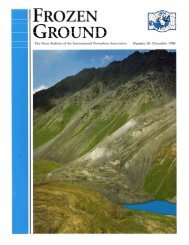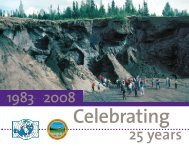Number 10, December 1991 - International Permafrost Association
Number 10, December 1991 - International Permafrost Association
Number 10, December 1991 - International Permafrost Association
- No tags were found...
You also want an ePaper? Increase the reach of your titles
YUMPU automatically turns print PDFs into web optimized ePapers that Google loves.
PRESIDENT'S COLUMNTwo meetings of the P A Executive Committee and oneday-long meeting of the Council took place in Beijing,China, in August just prior to the XIII Congress of the<strong>International</strong> Union for Quaternary Research (INQUA).The Congress was very successful, included 30 field excursions,and was attended by about <strong>10</strong>00 participantsrepresenting many countries. The three largest groupswere from China, U.S.S.R. and U.S.A. The P A Councilmeeting, formal and informal contacts with Chinese scientistsand engineers, and participation in INQUA activities,including field excursions, were very critical toplanning, understanding, and supporting the VI <strong>International</strong>Conference on <strong>Permafrost</strong> and associated fieldexcursions to be held in Beijing in July 1993.Participants in the INQUA Congress, whether on theirfirst mp to China or returning after earlier mps, could nothelp but be impressed with the continued eager cooperationof the Chinese with foreign associates, and also thecontinued increase in physical growth of the countrynewroads, hotels, local housing, and industry.Professor Cheng Guodong, Chairman of the OrganizingCommittee for the permafrost conference, and his staffhave been working vigorously in planning for the 1993conference. Excellent facilities for congresses in Beijingare available, and the Organizing Committee is planningto use accommodations and facilities that are less expensiveand more suitable for a meeting of 500 rather thanlarger conferences. To allow careful planning for thisimportant congress, the first P A conference in Asia, it isnecessary for potential participants to return participationforms and abstracts of papers by 15 February 1992(see back cover).The Organizing Committee has arranged interesting andimportant visits to cultural sites for which China is sowell known. These events are scheduled so that participantscan visit the Great Wall, Forbidden City, PekingMan Site and others as well as participating in the plenaryand paper sessions. The three permafrost excursions areunique to Chinaand have already drawn largenumbers ofapplications. I urge you to sign up soon. It has been apleasure for my wife and me to have worked in the threeexcursion areas: Tian Shan Mountains, northeast China,and Tibet, and I highly recommend all of these excursionsto examine the scientific and engineering aspects ofpermafrost and periglacial features there.In connection with the excursion to Tibet, it has been myprivilege to participate in two working field investigationsin the high plateau, 1980 and <strong>1991</strong>. Our <strong>1991</strong> tripfrom Lanzhou by bus to Golmud, Lhasa, and the Nepalborder in August permitted me and officials from theLanzhou Institute of Glaciology and Geocryology to gainfurther background information relating to the planningof the 1993 <strong>Permafrost</strong> Conference trip-Tibet, fromLanzhou to Lhasa.The Qinghai-Xizang (Tibet) Plateau rises to more than4500 m elevation. The climate is cold; mean annualtemperatures are -3" to -5°C and summer temperaturesrange from 15°C to the 20s. The Qinghai-Xizang Highwayis paved and reminiscent of the earlier days of theAlaska Highway. The road crosses the Kunlun Range,the high plains around the source of the Yangtze Riverand the Tanggula Range (at 5231 m117.162 ft). The highmountain zone contains spectacular glaciers above 500&6000 m and most of the plateau is underlain by permafrost.<strong>Permafrost</strong> conditions anr! engineering problemswill be demonstrated throughout the area.In the Kunlun Pass area (4780 m elevation) of thenorthern plateau, pingos exist in lacustrine sediments andthe highway is adjacent to a large pingo (4680 m elevation).Thispingo was 14 x 45 x 18 m high in 1975. At thattime, its top was removed using explosives and groundwatercreated a lake in the cavity. The lake was 20 m indiameter and drained in 1981 exposing the pingo ice inthe walls. It has been a dry pingo since 1989 and is easilyavailable for examination by Conference participants.Troy L. PCwC, President, PATroy L. PCwC and Nat Rutter, immediate past president ofINQUA, in front of large pingo of lacustrine sediments,Kunlun Pass, Tibet. (T.L. PCwC photograph No. PK 29,844,15 August <strong>1991</strong>.)Frozen Ground




